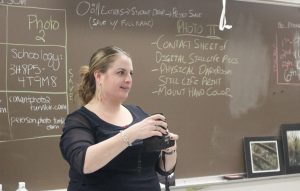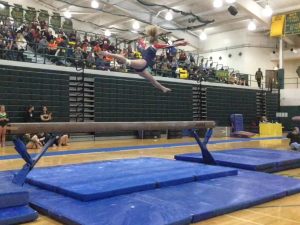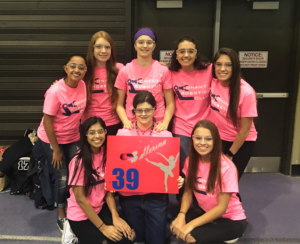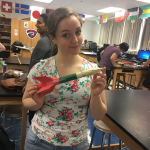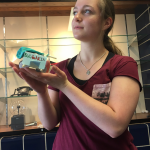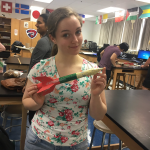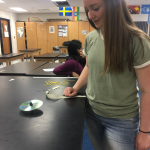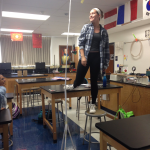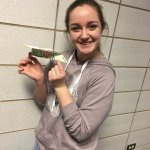While walking through the student cafeteria, one often hears complaints from students that “the teachers get way better food.” This rumor has floated around the cafeteria for years, but it has never been tested — until now. The Crier asked five students and four teachers to do a cafeteria swap, in which the students ate from the teacher cafeteria for two days and the teachers ate from the student cafeteria for three days. In the end, the results were surprising, and the truth behind the rumor was finally revealed.
The students
Allison Pariso, ‘18; Dylan Toth, ‘18; Michelle Zhang, ‘19; Nikita Basu, ‘19; and Archisha Ghosh, ‘19, are student cafeteria regulars, and they participated in the lunch swap, which took place during sixth period. They purchased and ate their food in the teachers’ cafe, and they said they were pleasantly surprised by the taste differences between both cafes.
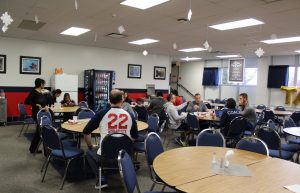 Michelle Zhang | Conant Crier
Michelle Zhang | Conant CrierThe inside of the teacher cafeteria.
Crier: What did you eat both days, and how did the food taste?
Pariso: I tried the specials that were offered on both days, which is not food that you can get in the student cafeteria. I tried the Tuscan ham sandwich the first day, which consisted of ham, onion, and cheese on a pretzel bun. On the second day, I had vegetable lasagna. Both the dishes were better than what I would normally get in the student cafeteria.
Toth: I only ate one day, and I had the Turkey and Mozzarella Panini. It was a lot like the one that is served in the student cafeteria. It tasted the exact same because the cafeteria worker got it from the student cafeteria. A lot of the teacher food is the exact same as the student food. The only difference is that teachers get specials.
Zhang: I wanted to try something new, so I had the teacher special both days. The first day the Italian sausage with potatoes. The second day I had the vegetable lasagna and roasted cauliflowers. On average, the taste was about the same; however, the specials were definitely better than the food in the student cafeteria. I felt like the lasagna tasted the best, and it would be a good option for vegetarians.
Basu: I ate a Turkey Panini the first day and lasagna the second day. I normally try to eat what I’m comfortable with, which is why I tend to lean towards the student options. The food tasted the same.
Ghosh: I ate a chicken wrap on the first day, which is normally found in the student cafeteria. On the second day, I ate lasagna, which was different from the student food. The lasagna had better taste than the pasta served in the student cafeteria.
Crier: Did the food you ate look like what you usually eat the student cafeteria?
Pariso: The food looked different. It was warm and also looked more like an entree I would order at a restaurant rather than cafeteria food.
Toth: I thought the food looked identical because I didn’t order a special. In fact, the cafeteria worker went to the student cafeteria to get the food.
Zhang: There were many options that were identical to the student cafeteria; however, there were other options, such as the specials, that looked a lot more appealing. That’s why I had the teacher special both days
Basu: The food offered in the teacher’s lounge looked better than what was offered in the student cafeteria.
Ghosh: On the first day, it did look like it was from the student cafeteria, but the food on the second day looked completely different.
Crier: What was it like eating in the teacher cafeteria? How did the cafeteria workers treat you? How did the other teachers treat you?
Pariso: It was definitely different than eating in the student cafeteria. It was smaller and much quieter. The seats were more comfortable and the tables were round instead of rectangular. … The cafeteria workers were also nice to us, but often had to ask their bosses to make sure they could serve us the food because the specials were supposed to be only given to the teachers. The same problem applied to payment.
Toth: The cafeteria workers treated us pretty much the same as they would in the student cafeteria. They were very nice, of course, as they all know how to treat students and teachers alike.
Zhang: It was a lot quieter and faster. The student cafeteria is way more chaotic. The cafeteria workers in the student cafeteria were actually nicer, but I think that this was due to the fact that the cafeteria workers in the teacher lounge were not used to having students.
Basu: It was quieter. The cafeteria workers did not like letting us purchase food from the teacher cafeteria. The other teachers gave us some strange looks but ignored us otherwise.
Ghosh: Eating in the teacher cafeteria is a lot quieter and lonelier. The cafeteria workers were polite and accommodating, and the teachers left us alone for the most part.
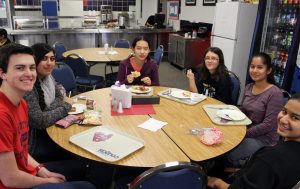 Michelle Zhang | Conant Crier
Michelle Zhang | Conant CrierThe students finish up lunch.
Crier: Did the teacher cafeteria have more options than the student cafeteria?
Pariso: The teacher cafe had specials, which the student one doesn’t have, and more options for snacks and drinks. However, most of the choices were similar, if not the same, as those in the student cafeteria.
Toth: Not as many as I thought. In fact, the student cafeteria has more options. The faculty cafeteria only had two special options, one of which was also available in the student cafeteria.
Zhang: I am not sure about more options, but they definitely had some better and fancier options.
Basu: The teacher cafeteria offered everything that the students received and more specialities.
Ghosh: The teacher cafeteria has at least two more options everyday compared to the student cafeteria. Everything from the student cafeteria is available in the teacher cafe.
The teachers
History teacher Denise Mitchell, P.E. teachers John Powers and David Cromer, and science teacher David Torpe usually eat in the teacher cafeteria, and they sometimes bring their own food from home. They purchased their food from the student cafe for three days, but they ate in different locations. Powers and Cromer took their food back to the teacher cafe, while Mitchell took it to her desk in the social studies office. Torpe, who ate at his desk the first day, bravely ate in the student cafe for the last two days of the swap.
Crier: How did it feel buying food from the student cafeteria?
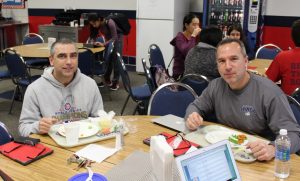 Michelle Zhang | Conant Crier
Michelle Zhang | Conant CrierJohn Powers and David Cromer sat in the teacher cafe, but they ate from the student one.
Mitchell: I went the second half of sixth, so the lines weren’t as long. Since I didn’t have to wait too long, it wasn’t that bad. The cafeteria workers were nice, and I was served right away.
Cromer: I felt like a true freshman. When I walked in, I saw there were so many lines, and I didn’t know which line was getting what. I felt a little bit of anxiety because I didn’t know what the options were. The whiteboards and menus around the doors really helped.
Powers: It felt different. It felt like I was in the way of the students, but once I saw the white boards on the door, everything went much faster. I almost got used to it by the end of the third day.
Torpe: The buying portion was simple, but I relived my Conant High School experience during those three days. I was not very popular in high school, and finding a place to sit in the cafeteria was always a challenge for me. It was a little uncomfortable. On the second day, I decided to sit with my students. They were really nice; one of them I have in my class. It was awkward at first, but it eventually became more comfortable once they saw I was there as one of them, not as a teacher.
Crier: What did you eat during the three days, and how did it taste?
Mitchell: I had the pizza, a burrito, and a sandwich. The options were quite similar to the ones I get from the teachers’ cafe. It tasted exactly the same; however, I will say that the teachers get specials that the students don’t. Those are very good. My personal favorite is the Tilapia. Another difference is that the teachers get sandwiches made fresh, and there is always a unique choice for soup.
Cromer: On the first day, I had a salad, which is what I eat typically every day. But on day two and three, I wanted to go outside my comfort zone. I decided to eat the panini. I got vegetables for my sides. The same people cook for both the teachers and students, so the quality of the food is the same. I think the idea that teachers get better food than the students is incorrect. The cafeteria workers don’t have anything against the students. The main differences are that the teachers get more entrees, and the student menu is held to a government health standard, while ours isn’t.
Powers: I had a salad because I eat one every day. Eating healthy is a big part of my life. I also tried some of the other options such as the pizza they offered. Like Mr. Cromer, I also got vegetable sides. The salad tasted the exact same, very healthy and delicious. The other food tasted very good as well. Overall, I tasted no difference between both cafeterias.
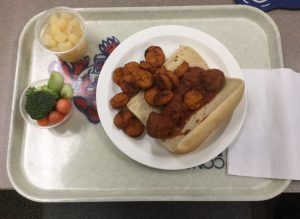 David Torpe
David TorpeDavid Torpe’s lunch on the first day.
Torpe: On the first day, I had the meatball sub with sweet potato bites. The following days, I ate the panini with vegetable sides. The meatball sandwich brought me back to my days here as a student. I don’t know if it is the same, but it really seems like it has not changed since I was here. I really enjoyed the sandwich as a student and now as a teacher. I think the bread is now wheat bread. The side I chose was the sweet potato “bites”, and they were much, much better than the tater tots that I remember from “old Conant cafeteria.” Also the napkins are way nicer now than years ago.
Overall feelings from students and teachers
All the students said they paid more for the teacher food, and the teachers said they saved at least a dollar eating from the student cafeteria.
“The specials were more expensive. They were four dollars on each day,” Pariso stated. Toth said that compared to four dollars, he pays two dollars and ninety cents for his food everyday.
Cromer explained that students couldn’t have all the options teachers had because of financial constraints. “The entrees are expensive, so students most likely wouldn’t be able to pay for them,” he continued.
He also said the belief that teachers had specials everyday was a myth. In fact, teacher entrees have been cut back from five days a week to three days a week in an effort to meet d211 budget cuts.
“We’re even trying to implement healthier options for teachers,” he said.
Both Powers and Torpe, who attended CHS as students, said they were reminded of their school days during the lunch swap. Powers said a lot of things in the cafeteria today are different than what he had as a CHS student.
“The lines were definitely different,” Powers said. “When I attended high school, we had four distinct lines: the salad line, the a la carte line, the snack line, and one for the entree portion.”
“Lunch was also only a dollar,” he continued, “and for a dollar and ten cents, we got a pizza and a shake on Fridays.”
Torpe felt everything was mostly the same, “The food was basically the same; I remember eating the panini as a student.”
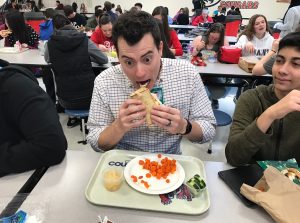 Aditi Katwala | Conant Crier
Aditi Katwala | Conant CrierDavid Torpe eats with his students on the second day.
Overall, the teachers said while they enjoyed participating in the swap, they wouldn’t eat in the student cafeteria again because they felt more comfortable in the teacher cafeteria. The students also agreed that they felt more comfortable in the student cafeteria and would rather eat there everyday.
“I’d rather eat with my friends,” Zhang said. “The student cafeteria is also much cheaper.”
From both the student and teacher testimonies, The Crier learned that the rumors about teachers getting better food isn’t necessarily true. All the food is prepared by the same cafeteria workers, so the quality of the food is pretty much the same.
